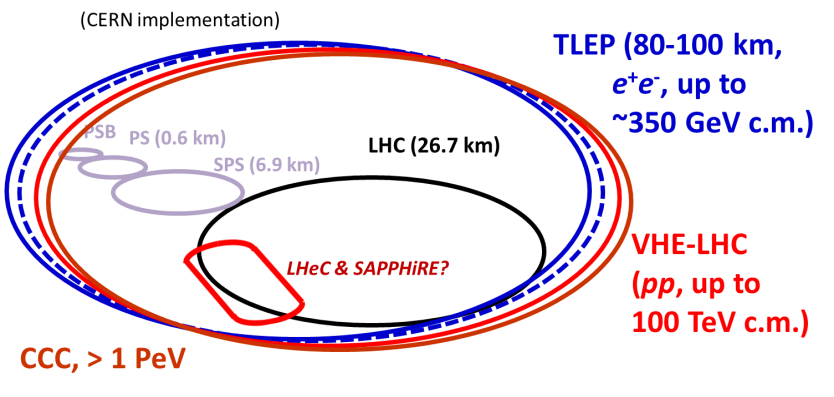![]() Exploring the accelerator frontiers
Exploring the accelerator frontiers


Fig 1: Schematic of a sequence of circular high-energy colliders after the LHC consisting of LHeC-SAPPHiRE, TLEP, VHE-LHC and CCC. Image credit: CERN.
Fig 2: Possible long-term strategy based on sequence of linear colliders. Image credit: CERN.
Discussing technologies and limits for future particle accelerators is key to defining a coherent long term strategy. In 43 workshops (co-)organized by EuCARD WP4 AccNet between 2008 and 2013, experts from all around the world drafted an R&D roadmap for the next 50-100 years.
Going beyond the state-of-the-art requires novel materials supporting higher magnetic or electric fields for acceleration or bending, e.g. stronger superconductors, dielectrics, plasmas or crystals. Energy efficiency and cost effectiveness are also becoming ever more important.
Taking into account emerging technologies, EuCARD WP4 delivered a coherent long-term vision for highest-energy circular colliders (Fig. 1). Encompassing a high-luminosity e+e- Higgs factory (TLEP or LEP3) and a 100-TeV proton collider (VHE-LHC), this approach could culminate in a circular crystal collider (CCC), boosting the c.m. energy to 1 PeV or beyond. An alternative “linear” approach (Fig. 2) would start with an ILC utilizing SC cavities, continue with CLIC, be followed by dielectric and plasma lepton colliders, and terminate with a linear x-ray crystal muon collider (XRCMC).
Remarkably, both linear and circular approaches require crystals to reach 1 PeV – for either acceleration or bending. Since crystals have been used only for bending so far, the circular route might be easier to follow. An ultimate limit is imposed by the Sauter-Schwinger critical field, constraining the minimum size of a Planck-scale collider to ~1010 m in either approach.
